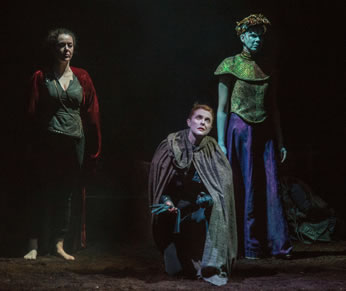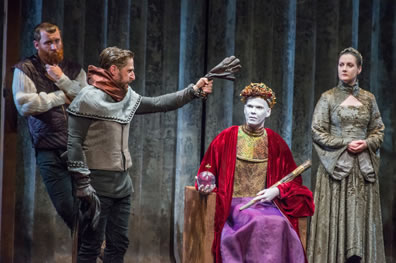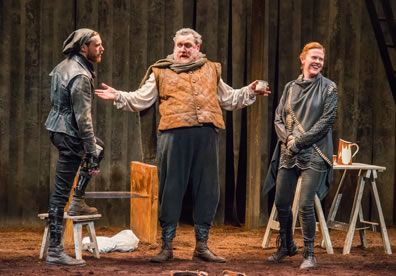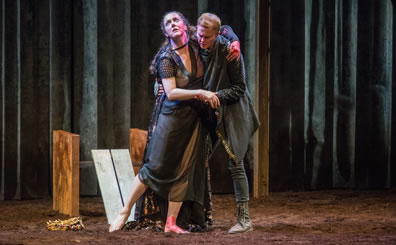DruidShakespeare: The History Plays
Four Plays Stitched with a Common Thread
Druid Theatre Company, Lincoln Center Festival, Gerald W. Lynch Theater at John Jay College, New York, New York
Saturday, July 11, 2015, G–5&7, left orchestra
Directed by Garry Hynes

Henry V (Aisling O'Sullivan, center) meditates on kingship on the eve of the Battle of Agincourt as his predecessors, Richard II (Marty Rea, right) and Henry IV (Derbhle Crotty, left) look on in DruidShakespeare: The History Plays. Photo by Stephanie Berger, Lincoln Center for the Performing Arts.
Who are we, really? Kings and queens, presidents, prime ministers, and even campaigning politicians use the royal we to denote themselves and, by extension, their people. But by whatever means they become our leaders—direct vote, indirect vote, acknowledgement of divine providence—does that still make them we?
Such questions rise to the surface as we (that would be Sarah and me and an audience of some 500 people at John Jay College's Gerald W. Lynch Theater in New York) watch the Druid Theatre Company's production of William Shakespeare's second history cycle—Richard II through the two parts of Henry IV to Henry V—in one sitting. As part of the Lincoln Center Festival, this ambitious, 13-actor undertaking by the Galway, Ireland–based troupe survives some debilitating textual cuts and the occasional pedestrian performances to deliver seven hours of satisfying theater and some great Shakespearean moments while wringing out thought-provoking interpretations of the text.
The series is divided into two parts, with Richard II and Henry IV, Part One, making up Part 1, and Henry IV, Part Two, and Henry V comprising Part 2; 20-minute intermissions separate each play. Weekend marathon presentations, which we attended, provide a 45-minute intermission (and option of a box dinner), between Parts 1 and 2.
Making these four plays a uniform whole is no easy undertaking as they each have different styles of composition. Richard II is 100 percent verse, Shakespeare's most poetic play filled with rhyming couplets, long speeches, and ceremonial passages. Henry IV sits near the opposite end of Shakespeare's composition spectrum, an easy-going, prose-prevalent play with extended scenes of notably unceremonial behavior. Henry V lies in the middle of the spectrum, with a Chorus-framed structure and a mixture of formal court passages and romping commoner scenes. Even the two parts of Henry IV shift in approach: Part One focuses on the world of the court and civil war with Falstaff and his cronies as a subplot; Part Two becomes the Falstaff show, a series of comic set pieces leapfrogging scenes of crown conflict in which Hal's ascension to the throne is presented in the context of his rejecting Falstaff.
Yet, compressing the four into one production brings common themes to the fore and allows individual characters to flesh out lifelong arcs—or die young. We also see that despite their distinctly different personalities, the three titular characters navigate the same waters, adventuring overseas and dealing with homeland conspiracies. What changes is the management style of the guy at the top, and that turns out to be an evolution from Richard to Henry to Hal. However, what doesn't change is the real story DruidShakespeare wants to tell.
Adapted by Mark O'Rowe and under the direction of Garry Hynes, DruidShakespeare manages to maintain a consistent tone and structure throughout its seven hours, not only through costumes and set, but also through choice of cuts—which range from palatable to painful—and rearrangement of roles. Designer Francis O'Connor (with Doreen McKenna as co-costume designer and James F. Ingalls as lighting designer) gives the action a rustic setting. Dirt covers the stage, a metal superstructure serves as a bridge and upper platforms, and at the back is an ever-expanding cemetery that is obscured by a worn-wood-paneled backdrop lowered at the start of each play. To the left, about four dozen apricots dangle on vines for Richard II; those vines bear no fruit during the Henry IV plays but yield white flowers for Henry V. On the way to the Battle of Shrewsbury in Henry IV, Part One, a backdrop of wide plastic strips, decorated with bushes and small trees, lowers; during the battle, the armies smack on these strips with their sticks, creating the effect of gunshots and distant cannon fire as background noise to the action at the front of the stage.
With notable exceptions, the characters wear vaguely medieval-like clothing combined with leather pants, denim jackets, and metal-studded trim. The exceptions are Richard II (Marty Rea) looking like Pharaoh Ramses in floor-length purple skirt and gold brocade bodice, and the French lords in Henry V wearing yellow body armor over blue clothes with green capes. These French speak their lines while engaging in choreographed fencing displays, a silliness that stands in stark counterpoint to the mostly serious staging of the rest of the series, serving as delightful comic relief while allegorically distancing the flippant French court from the drudgery of the English lifestyle.
The opening scene in Richard II moves directly from Bolingbroke's and Mowbray's challenge to Richard's banishment decree (suggested to the king by Bagot, played by Rory Nolan, in whispered conference). Not only is the play's second scene between Gaunt and the Duchess of Gloucester gone, so are all the ceremonies of the lists at Coventry. The gage scene in Parliament is out, too, a personal favorite of mine but a logical chop. Long speeches are trimmed, including Gaunt's "sceptered isle," an edit that hews the speech closer to its intent as a railing against Richard rather than a reverie of patriotism. The comical York begging scene has been replaced with York (John Olohan) insisting on talking with Henry (Derbhle Crotty) alone and then showing him the letter of conspiracy. Aumerle (Gavin Drea) not only gets no chance to beg for mercy in this telling, he's among the rebels whom we later hear are executed (this production inserts Aumerle into that list).

Richard II (Marty Rea) watches as Mowbray (Aaron Monaghan) takes up the gage of Henry Bolingbroke as Bagot (Rory Nolan, left) and Queen isabel (Charlotte McCurry) look on in DruidShakespeare: The History Plays. Photo by Stephanie Berger, Lincoln Center for the Performing Arts.
This handling of Aumerle illustrates O'Rowe's overall thematic intent with this project. Two recent, popular productions of Richard II, RSC's 2013 version and the BBC's Hollow Crown series, have expanded Aumerle's role by making him, rather than Exton, Richard's assassin. This is an attempt to infuse Shakespeare's script with a gotcha element where none is needed while removing the more serious gotcha of Henry's political manipulations. DruidShakespeare brings home Henry's culpability in the murder by casting Aaron Monaghan in the part of Exton; he also plays Mowbray.
In history, Mowbray, with the tacit support of Richard II, was believed responsible for the murder of the Duke of Gloucester, Richard's uncle and Lord Protector. That incident serves as a subtext to the opening scenes of Richard II, as Henry Bolingbroke accuses Mowbray of the murder and implicitly taints the king, too. This explains why Richard interrupts their duel with the sentences of lifetime banishment for Mowbray but only 10 years for Henry (later cut to six by Richard and eventually defied by Henry). When faced with a similar circumstance, the newly crowned Henry banishes Exton for Richard's murder, and Monaghan gives mirror performances of Mowbray at the beginning of the play and Exton at the end of the play striding disgustedly across the stage and into banishment for carrying out the wishes of their monarchs.
As for Aumerle, although he is a key participant in Richard's character arc and historically goes on to serve Henry V (part of the point of Henry IV pardoning him for his role in the conspiracy in the last act of Richard II), Shakespeare drops him from the rest of the cycle. This gives O'Rowe license to assign Aumerle the status of political pawn, and instead of showing him pardoned as Shakespeare does, O'Rowe kills off what hitherto has been a prominent character in Richard II with a mere mention in a list of names.
The cuts and interpolations in Richard II don't undermine the play's foundational integrity, but those in Henry IV, Part One, serviceable though they may be for trimming the play's length, leave us with something sub-Shakespearean. Gone is Hal's "I know you" soliloquy, Vernon's description of Hal's preparation for battle, and Falstaff's soliloquy on honor. Gone are Lady Hotspur and Glendower and with them Hotspur's brilliantly comical moments. These cuts gut the play of its soul, leaving us with little more than a political docudrama.
This trend continues with Henry IV, Part Two: No Rumour (the Induction), no Northumberland scenes, no Falstaff capturing the rebel knight Coleville, no soliloquy on booze, and no pricking the rolls of draftees, one of Shakespeare's funniest comic pieces. The Gloucestershire scenes have been condensed and combined into one, serving only as prelude to Falstaff's rejection by Hal at the end. Strangely, while the production as a whole focuses on political maneuvering and court intrigue, it cuts out Northumberland's fleeing to Scotland and Prince John's duplicity in Yorkshire. Meantime, Henry IV himself becomes more prominent. This production opens Henry IV, Part Two, with the king's sleep-deprived soliloquy on the uneasy head that wears the crown (Act III, Scene 1) before jumping back to Falstaff's encounter with the Lord Chief Justice (Act I, Scene 2).
The most extensive rearranging of scenes comes in Henry V. Trims to the dialogue and speeches are extensive, and the two Katherine scenes—yes, even Henry's courtship of the princess—are among the passages totally cut. Strangely, Henry's purposeless prank on Fluellen (Garrett Lombard) with the soldier's glove remains. Meanwhile, O'Rowe and Hynes insert a thematic device during Henry's eve-of-Agincourt soliloquy as both Richard II and Henry IV emerge from the back of the stage and come to a stop behind Henry V (Aisling O'Sullivan) in midsoliloquy. Richard hands the crown to Henry IV who places it on his son's head. This ties up the tetralogy in a symbolic bow linking the kings and their cares. However, a keener thematic strand is still twisting into a knot, a thread that starts with the hanging of Bardolph (Clare Barrett) earlier in the play.
Though Shakespeare keeps Bardolph's execution offstage, this production, as do many others, incorporates the moment into the action. But here, Bardolph's body remains on the stage through subsequent scenes. In the battle of Agincourt, not only is the boy killed, but Nym (Charlotte McCurry) and Pistol (Monaghan) are, too, and remain on stage as Henry reads off the tally of dead and then marches off stage to the singing of Non nobis and Te Deum. "The dead with charity enclosed in clay," Henry says, "and then to Calais, and to England then, where ne'er from France arrived more-happy men." A moment after king and company's exit, the Eastcheap companions come back to life to enact, as if in flashback, Act II, Scene 3, in which they recount Falstaff's death with Mistress Quickly (Olohan), who has joined them onstage. After the Eastcheap lads take their leave and head off to the war in France, Mistress Quickly remains alone on the stage, sitting on the seat that has served all the monarchs previously and staring out into the audience as the lights go down. Her expression is that of a woman who is a little lost, a bit helpless, and yet resigned.
For the common English folk who end up bearing the brunt of the political maneuverings among the nobles, nothing really evolves from Richard II to Henry IV to Henry V. The only thing that changes is the number of graves at the back of the stage.
The first grave is apparently Richard's. A man is digging the grave before the first scene of the first play, and as we leave for the first intermission at the end of Richard II, we now believe it to be Exton, for we see Monaghan shoveling dirt from the pile into the grave while the shroud that he had wrapped around Richard's body lies nearby. Monaghan makes other intermission appearances, too, and occasionally during plays we'll see hooded characters dressed like him walking across the stage extraneous to the action. In the last intermission, between Henry IV, Part Two and Henry V, Monaghan duteously and carefully rakes the dirt on stage, getting up on the platform that has served as the throne to rake the very last inch where he had stood. As he raises his rake in triumph, the audience applauds his accomplishment, whereupon he says, "O for a muse of fire, that would ascend the brightest heaven of invention." He continues on with Chorus's opening speech and continues in that role, which remains largely intact. It's a clever device, justifying the presence of Chorus, the element that most distinguishes Henry V from the other three plays, by intimating that he has been on stage through the three previous plays.
Some of the most profound elements of this production come from the combining and casting of the many characters. For example, in Richard II after the death of John of Gaunt (Bosco Hogan) and Richard's seizure of his estate, Shakespeare has Northumberland, Ross, and Willoughby remain on stage to speak the first reports of Bolingbroke's return and conspiracy against the king. DruidShakespeare replaces Ross and Willoughby with Northumberland's brother, Worcester (Monaghan), and son, Hotspur (Lombard), the same family unit that leads the conspiracy against Henry in the next play. Ross's line, "To horse, to horse!" is thus spoken by Hotspur, a smile-worthy foreshadowing of his infatuation with his horse during his scene with Lady Hotspur in Henry IV, Part One—except that particular scene ends up among the excised, thereby abandoning a promising leitmotif.


Top: Hal (Aisling O'Sullivan, right) jokes with Poins (Gavin Drea, left) and Falstaff (Rory Nolan) in DruidShakespeare: The History Plays. Bottom, Hal assists his sick father, Henry IV (Derbhle Crotty). Photos by Stephanie Berger, Lincoln Center for the Performing Arts
Cross-gender casting also carries thematic resonance. Marty Rea's Richard II is androgynous, outfitted in what could pass as a ball gown and wearing white makeup that he rubs off after being imprisoned at Pomfret. Crotty plays Henry IV full of virility in the first two plays even as her faux armor enhances her feminine figure, and in Henry IV, Part Two, the king's nightgown leaves little of Crotty to the imagination. With Hal also being played by a woman in tomboyish manner, I would dismiss my reaction to Crotty's Henry as my own prurience if not for the portrayal of Mistress Quickly by Olohan. With his full beard tied in bows and his pants visible under the frame of a petticoat, he makes little effort to appear believably as a woman. So, while the monarchs are not distinguishable by gender, this history's final image turns out to be Mistress Quickly as an everyman and everywoman—the we.
In addition to this powerful thematic arc across the four plays, individual performances and interpretations stand out. Rea's Richard is childish throughout, even in the Flint and Parliament scenes, and amazingly these scenes' grand lines are perfectly suitable when spoken by a man with the maturity of a 6-year-old. He switches on a dime from squealing laughter to intense anger, viewing his world as the playroom where he commands by consciously molding his face into a stern look—perhaps emulating his late father, the Black Prince. With the naïveté of a child, Richard sees through the veil of social decorum and speaks with an innocently perceptive truth. He laughs derisively when Bolingbroke kneels to him at Flint, and after tenderly reaching to the sobbing York with "Uncle, give me your hands" he suddenly pushes York's face away with an angry "Nay, dry your eyes. Tears show their love, but want their remedies."
Crotty's Henry maintains a public veneer that generally holds up until his illness saps him of his energy in Henry IV, Part Two, his face covered in red splotches. Yet, early in Part One we get the clearest peek into this Henry's true nature when he publicly meditates on his wish that "it could be proved that some night-tripping fairy had exchanged" Northumberland's Harry Hotspur with his own Prince Hal. Crotty pauses for a moment, and we see that her Henry is not merely wistfully fantasizing but genuinely conspiring to somehow make that wish a reality. This Henry views nothing as beyond his grasp, which is why his subsequent illness so devastates his psyche.
O'Sullivan's Prince Hal, meanwhile, comes off as a surly brat. She plays the role with no convincing emotional connection to Falstaff. I'm not sure that was intentional staging or missing chemistry, but it makes the prince generally unappealing. Her Hal has more of a connection with his father, even though in their first interview, Hal comes on like an impertinent teen, giving a quick curtsy with a "what-ev-ver" demeanor. After Hal becomes King Henry V, O'Sullivan plays the part with more gravitas, even giving a stiffly formal reading of the king's "Once more unto the breach" speech. By contrast, the Saint Crispin's speech is as stirring as any rendition I've seen. What's most notable, though, is that by the time we get to Henry V, O'Sullivan's Hal seems very much the product of not only his stubborn father, but of the petulant Richard II, too.
Rory Nolan is exemplary as Falstaff, which further deepens the loss of his cut scenes and speeches. Karen McCartney plays his page as a little Peter Pan. She preens like a little boy of great importance, soaking in the adult shenanigans going on around him, but when McCartney's Boy gets bored he plops down on the stage and sucks his thumb.
Monaghan scores memorable performances in every role he undertakes: the loyal Mowbray, the politically ambitious yet practical Worcester, the misguided Exton, the silly Dauphin, and the audience's best buddy, Chorus. His biggest triumph is as Pistol, the Tamburlaine wannabe who seems perpetually out of synch with his social environment and thus maintains a slightly baffled expression as nothing and no one meshes with his skewed worldview. He stalks across the stage with one foot stuck straight out, unable to bend his knee—obviously having shot himself in the leg some time ago, based on the way he flings around his pistol in one hand and sword in the other. Though Shakespeare tones down his wild depiction of Pistol in Henry V, Monaghan maintains the same manic energy from one play into the next, especially in his nonbrawl with Nym at the beginning of Henry V. Yet Monaghan inserts an ever-so-subtle moment of connection with Mistress Quickly in his first scene in Henry IV, Part Two, a passing glance that will ultimately lead to their marriage in the next play.
Along with Nolan's Falstaff and Olohan's Mistress Quickly, Monaghan's characters, whether they represent second-tier nobility in Mowbray, Exton, and Worcester, or London's lower class in Pistol, or the audience in Chorus, are the beating hearts of DruidShakespeare: The History Plays. The three kings may be the titular roles, but the real tragic heroes are we the people.
Eric Minton
July 30, 2015
Comment: e-mail editorial@shakespeareances.com
Start a discussion in the Bardroom



 Find additional Shakespeareances
Find additional Shakespeareances